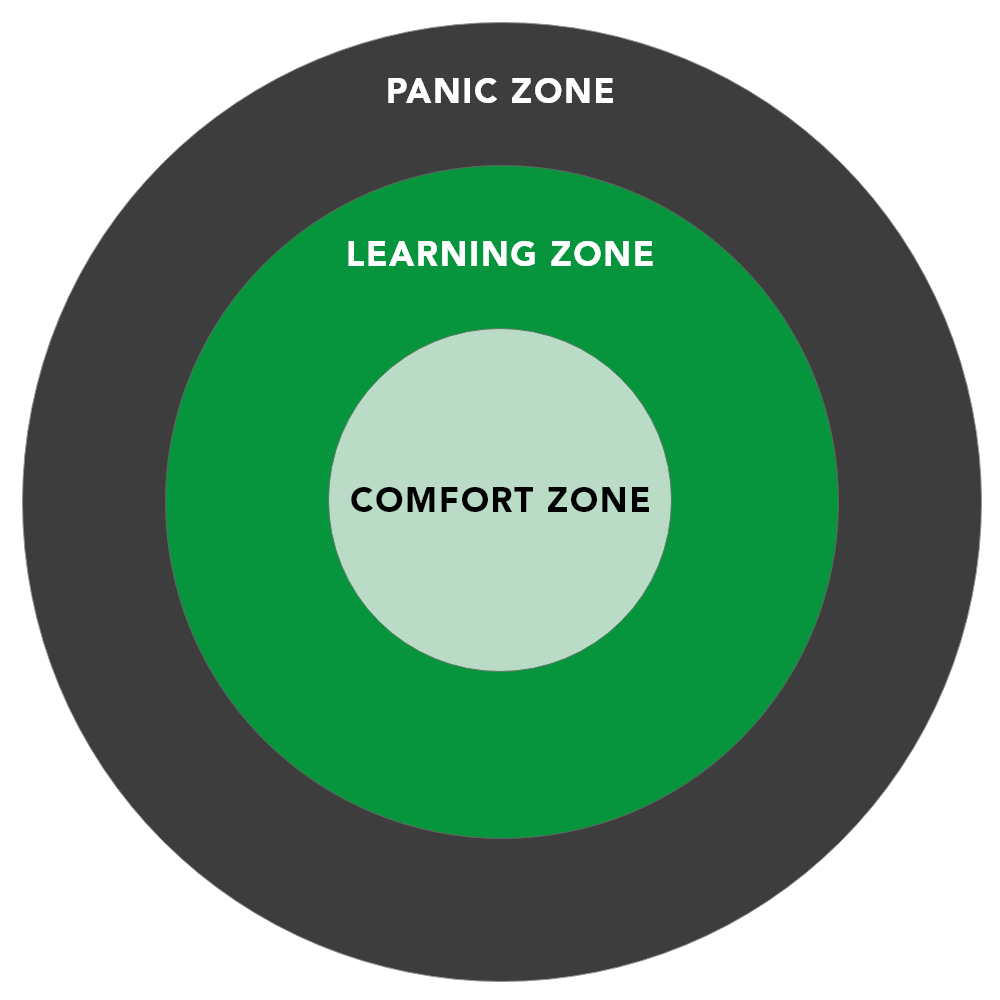The Learning Zone Model And How To Apply It
Every day, I drive past this cute ballroom dance studio and one day recently I finally decided to check it out. I don’t want to dance alone, so I’ve convinced my partner to join me—but dancing is definitely out of his comfort zone.
In the learning community, we know that if we’re not pushed hard enough, we won’t move beyond our comfort zone. But if we’re pushed too hard, we start feeling panicked and overwhelmed. In either scenario, these are barriers to learning.
Many things will contribute to my partner’s comfort in learning to dance:
- Is it low-risk or high-risk learning?
- Is it the appropriate level of challenge?
- Is it an appropriate progression of challenge?
But even if we get the perfect level of risk, challenge and progression, he will still be uncomfortable because comfortable learning doesn’t stretch us. As professor and researcher Brene Brown says, “If you’re comfortable, I’m not teaching and you’re not learning.”
The Learning Zone Model
Psychologist Lev Vygotsky first codified this in the Learning Zone model:
- Comfort zone: Where you feel safe and secure in your confidence and competence because everything is routine and familiar. It requires little effort, but there isn’t much learning or innovation here.
- Stretch/Learning zone: Where you experiment, stretch your knowledge and skills. Learning or re-learning happens here and can feel energizing and positive (and also uncomfortable) but you have the resiliency to handle the discomfort.
- Panic zone: Where the challenge is too far out of your comfort zone, so you spend all your energy dealing with the overwhelm of anxiety and panic that you have no capacity left for learning. This can often have strong physiological responses, creating further barriers of anticipation anxiety about future learnings.

What most people miss about the Learning Zone model is how the stretch/learning zone feels.
It should feel the same as a really good, relaxed physical stretch! Neither a lack of effort nor grit-your-teeth pain. But only the learner can assess how it feels. Especially because it will feel different for each of us.
I know my body better than anyone else, so if I’m in the middle of a yoga move like upward dog, I am in control of finding the “sweet spot.” Just like my partner knows when he is reaching the panic zone in our salsa lesson. In both instances, we are in control.
But how do our learners have control of finding the “sweet spot” in eLearning? Especially when all of our comfort zones are different, and many eLearnings are one-size-fits-most?
Putting Learners Back In Control
Let’s explore three ways to put the learner back in control.
1. Using A Diagnostic Pre-Assessment
Have you ever been bored by a lesson that was too easy? Or frustrated by a lesson that is too challenging? Consider using a pre-assessment that measures learners’ current skills and knowledge to create a targeted learning path for each individual—those completely new to the core concepts, those who are more advanced, or those learners wanting to refresh their skills and knowledge. Based on the pre-assessment, microlearns or chapters within the module may be recommended to learners to personalize each learner’s training plan, or learners could skip these microlearns based on their assessed skills and knowledge.
2. Bookmark Progress
Sometimes, the best thing to do when we panic or become overwhelmed is to take a break. We can come back when we are feeling more resilient and able, and sometimes that means waiting for a day or two. But nothing is more demoralizing than having to redo everything you had already done because the learning did not save your progress. We chunk the learning to prevent cognitive overload, but we also chunk learning to prevent emotional overload. Allow the learner to stop and start as they are ready and able.
3. Allowing Re-Dos With The Right Amount Of Feedback
When I am practicing, if I don’t nail my pirouette, I don’t just move on to the next dance move. I try again and again until I get it right. For learners, like me, who want to get it right, give us a second chance. Many eLearning assessments allow us to re-do, but it can go wrong when the feedback reveals the correct answer instead of allowing for self-discovery. When this happens, the learner is not synthesizing the feedback and reapplying what they know. They are simply going back to identify the right answer (and from Bloom’s taxonomy of learning, we know this is lower-level thinking!). Even better, what if the learner got the question wrong and instead of redoing the exact same question, a new question assessed the same skill or knowledge in a new way? Because true assessment will assess if the learner can independently do or know without the help of feedback.
In salsa dancing, we did all of these. And while this was exemplary instruction, what ultimately sold my partner on dancing was giving him control of how far he is pushed. When we fear not being in control and consequently being forced into the panic zone, it becomes a barrier to learning. For many learners, like my partner, it is helpful to share how they are in control (progress is saved here, take a break here, etc.).
Control can offer comfort, expanding the comfort and stretch zones and decreasing the likelihood of entering the panic zone.

Kineo
Kineo helps the world’s leading businesses improve performance through learning and technology. We combine quality in learning with award-winning customer service and innovation. We’re here to take on your learning and performance challenges – and deliver results.
Originally published at kineo.com.



















